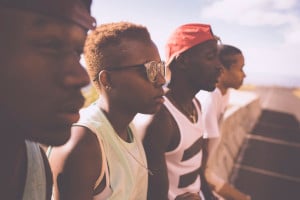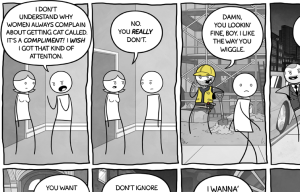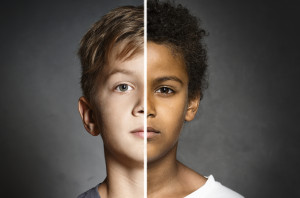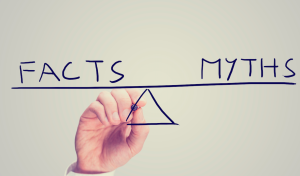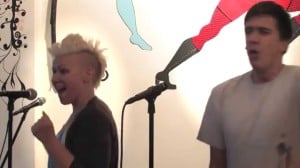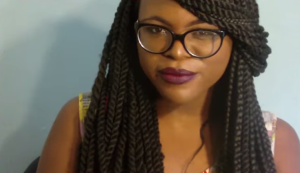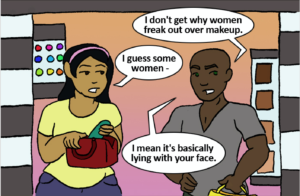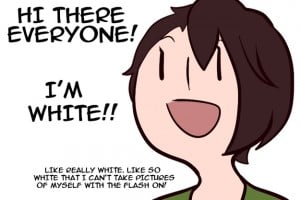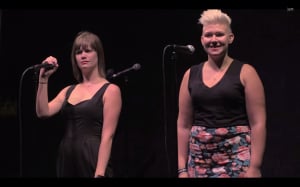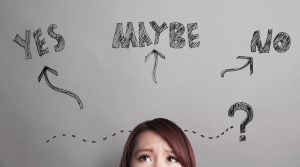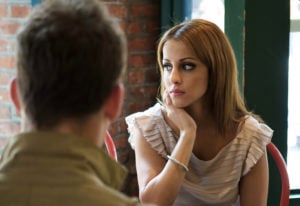We can agree that violence against children is a terrible thing.
It’s not hard to find support for the stance that child abuse is not okay. For most of us, the thought of a grown adult physically attacking a child immediately brings up sympathy for the child, anger at the adult’s behavior, and willingness to change any system that would allow this to happen.
So why does the level of support drop so significantly when talking about violence against Black children, especially at the hands of authority figures?
In this case, there are even additional factors to churn our stomachs – the abuse of power, the fact that people sworn to protect us are attacking kids, the fact that racism is so insidious that some children can’t even have a carefree childhood before they’re forced to face its violent nature.
And yet, a lot of people try to find reasons to defend the police officers who brutalize Black children.
Many believe they’re just being objective. You might think you’re just considering all sides of the story, and coming to a logical conclusion that a police officer did what they had to do.
Some people reached this very conclusion after watching a video of an officer at Spring Valley High School in South Carolina slam a girl to the ground, drag her, and handcuff her.
Even some of those who don’t condemn Officer Ben Fields admit that he went overboard. But they’re still holding on to all kinds of reasons to blame the victim, saying that the girl should’ve been more obedient, and she somehow got what she deserved.
It’s hard enough to watch this video of a grown man tossing around a child. It’s even more heart-wrenching to know that people – even people who would condemn any other form of child abuse – are willing to find any reason to excuse what happened to her.
With this level of victim-blaming – that is, blaming children for adults’ violence against them – it’s no wonder so many Black children get trapped in the school-to-prison pipeline. Children of color are more likely to receive harsher punishments, to have the police called on them, and to be sent to jail, where they’re traumatized by high rates of sexual abuse and more.
When we ignore or condone police violence against Black children, we support this horrific system, whether we mean to or not.
Can you imagine raising a Black child in these conditions? Watching your three-year-old’s vivacious personality emerge, and getting the sinking feeling of knowing his outbursts at school will be punished not with time-outs, but with multiple suspensions. Can you imagine being a Black child in these conditions? Having no safe space to express your emotions, and spending your time wondering, “Why am I a target?”
And knowing nobody will protect you from this violence, because people who read your story see a young criminal when they look at you.
Here are the most common reasons I’ve heard excusing police violence against Black youth – and what they’re missing.
1. ‘We Don’t Know the Whole Story’
The video of the assault at Spring Valley High School begins just before the violence starts, so many responses include a common refrain: “We don’t know the whole story.”
Essentially, this means that we should wait to decide if Officer Fields did something wrong, because we might get more information that gives us reason to blame the victim.
It’s true that the video is short, but it shows enough for us to know this: The officer had power over the student in size, strength, and authority. She sat in her seat, posing no threat to him, before he physically and violently threw her around, leaving her with bruises and a cast.
What kind of information could possibly justify that?
And why in the world would we want to justify that? One of the most common words associated with childhood is “innocence.” In most other cases of adult violence against a child, there’s no question of the victim’s innocence.
We know that if nothing else, they are young, and they are small, and they are still growing and learning – so it’s shocking to think that a grown adult would choose to use violence against them in any situation.
But that would require recognizing this Black child’s humanity. In this case, many people don’t want to believe she’s innocent, and they don’t feel the sympathy they would for another young victim of violence.
Don’t get me wrong, I understand that the more details we have, the more we understand about what happened. But seeking information shouldn’t mean looking for reasons to blame the victim.
In this case, nothing the victim did could have made this violence necessary. We already know that this man – whose presence at the school supposedly keeps students safe – initiated violence on a child.
So far, details of the “whole story” include Officer Fields’ nicknames – students knew him as The Incredible Hulk, for his size, and Officer Slam, for his pattern of violence against students. His record shows lawsuits for terrible violence against citizens.
The whole story includes systemic racism, which has law enforcement targeting Black girls throughout the United States at much higher rates – and often more violently – than white girls. It includes the fact that this victim lives as a target of this system, and without her mother in her life.
People are so quick to discuss mental health issues when it comes to mass murderers like Dylann Roof. But many of these same people want to talk about what a Black child did to “provoke” a law enforcement officer’s violence, rather than why a man who is supposed to protect children initiates violence against them instead.
Meanwhile, we’re not talking about the emotional state of the traumatized child whose Blackness is treated as a threat in the classroom. Instead of “what did she do wrong?” we should be asking about how she’s hurting, and what she needs. Just like any other victim of violence, this young survivor needs our support.
2. ‘These Kids Aren’t Following the Rules’
Do you believe a misbehaving child deserves to be assaulted or killed? I sure hope not, because that would put every child at risk for violence. All children misbehave at some point, and I’m sure you can recall bending or breaking some rules when you were growing up.
So I have to wonder why so many people criticize Black children’s behavior when they’re targeted for violence.
“My kids would never act out like that.” “That’s how you have to deal with disrespectful kids these days!”
There’s a double standard when it comes to how society “deals with” Black children.
Authority figures shouldn’t have the power to physically attack children if they disobey. But the same behaviors that are considered normal for white youth, that are seen as kids just being kids, are often criminalized for children of color.
There’s a disturbing recording of Texas Officer Rigo choking and slamming 14-year-old Gyasi Hughes at school. Some people watched closely to see what the teen did to “provoke” the attack, and concluded that – even though Gyasi posed no threat to the officer – it was an appropriate way to deal with him.
Even if the student had been “disobedient,” disobedience isn’t the same as being a threat, but Black children like Gyasi are so often treated like they’re inherently threatening.
Police are supposed to be trained to keep us safe. That means they should be able to de-escalate situations without violence – and certainly not be the ones to initiate violence. It’s ridiculous to expect a child who’s feeling threatened and scared to have better de-escalation techniques than a trained adult professional.
By criminalizing normal childlike or teenage behaviors, we’re hurting and killing children of color. As Greg Howard writes in “There Are No Innocent Black People,” “When students owe subservience as the price of not being assaulted, schools become prisons.”
We must have other ways of addressing children’s behavior, so we can set youth of color free.
3. ‘It’s Not About Race’
It’s not just schools that are prisons. Children of color are being profiled by law enforcement at public pools, and stores, and sidewalks, and more. Just like the adults in their lives, they’re the targets of an unjust criminal justice system.
The numbers show that Black youth are more likely to be treated as criminals than white youth. But when it comes to individual incidents, some people still deny that officers’ motivations have anything to do with race.
It’s true that there can be other factors involved in police brutality – things like disability and mental illness also make young people more likely to be targeted. But the numbers also show that police officers can hold implicit racial biases – meaning, even if they’re not consciously motivated by racism, they can act on the unconscious belief that Black youth are dangerous.
Unfortunately, there are many examples of how these beliefs put Black youth and other children of color in danger.
For instance, when Officer Eric Casebolt arrived to break up a McKinney, Texas pool party, he targeted only children of color, pinning bikini-clad Black teenager Dejerria Becton to the ground and pointing his gun at her friends. White teenagers stood by filming the attack, unharmed.
There’s no doubt that this incident was about race – and a recent report shows that it’s not the only one. Police in that school district arrest and ticket Black students at much higher rates than other students.
People want to believe that racism is over, so these incidents would unfold the same regardless of race. But, as the numbers tell you, that’s simply not true.
D.C. teenager Jason Goolsby can attest to this racial bias, too. He visited an ATM, held the bank door open for a white couple, and lingered with two friends for about twenty seconds before leaving the bank. This everyday behavior resulted in police tackling and handcuffing him after the couple called 911 to say they felt “uncomfortable” around the teens.
If this wasn’t about race, then Black youth would be free to participate in ordinary activities like having pool parties or visiting the ATM without being assaulted by police.
4. ‘They Were a Threat’
People find many reasons to say that a police officer “had” to use violence against Black children. They say the young person must have been so out of control, so threatening, that only violence could subdue them.
The big threat here is the fact that so many people see Black children as older and more guilty than their white peers – this bias is endangering Black children’s lives, as law enforcement officers use more force against them, and are likely to have that force deemed justified.
Tamir Rice was twelve years old when he was gunned down by a police officer, who later said he thought Tamir was “about twenty.” The officer arrived at the playground where Tamir was walking with a toy gun, and took less than two seconds to shoot him dead.
The shooting has been ruled “justified.” Our justice system says that it’s reasonable for police officers to kill children before they accurately assess the situation, and that’s not okay.
Do you really have to wonder, “Why did they run?” when a young Black person acts out of fear of police? Despite all of the evidence about the danger of police, some people point to any act of self-protection on the part of an unarmed child as a bigger threat.
They point to a video of a sixteen-year-old boy in Stockton, California being tackled by nine police officers after jaywalking and say that the teen is “resisting.”
His “resistance” was shielding his face from baton strikes. Wouldn’t you do the same if you were under attack?
The truth is that many of the children being targeted for violence pose no threat at all – and the biased perception of a threat based on skin color is not an acceptable excuse for killing, injuring, and traumatizing children.
Blaming young victims for attacks against them is a terrible way to practice “justice.”
5. ‘The Police Were Just Doing Their Job’
You may have heard about some of these cases and pitied the officers who acted violently.
“It’s a tough job,” you say, and it’s unfortunate that it had to come to violence.
But as these cases show, these incidents are more than unfortunate – they’re tragic, and so often, they’re completely avoidable. And if attacking unarmed children falls within police officers’ job responsibilities, then something needs to change.
In Louisiana, an autistic ten-year-old girl had an outburst in class and climbed a tree. When her grandmother arrived on the scene, she found the terrified child handcuffed and pinned, with an officer pressing her face into the ground.
How is this acceptable? How can we allow adults to terrorize the children they’ve sworn to protect?
In schools and neighborhoods where police criminalize and target young people of color, many children are already suffering from the effects of poverty and violence. The same children most likely to live in poverty are the least likely to have their mental health needs met. And Black youth are more likely to have their behavior criminalized – even when white youth demonstrate more of that behavior, like drug use.
It’s hard enough to grow up in with the struggles of poverty – and we’ve essentially criminalized being a child who’s poor and Black. Instead of support systems, these children have the constant presence of the criminal justice system introducing them to the harsh realities of systemic racism and mass incarceration. They don’t need more trauma – they need people to take on the job of helping them heal.
***
If our children aren’t safe at school, on playgrounds, or at pool parties, where can they be free?
Many Black children aren’t even safe from police in their own homes – seven-year-old Aiyana Stanley-Jones was sleeping on her grandmother’s couch when officers raided the wrong house. Joseph Weekley, the man who shot Aiyana in the head and killed her, had all charges against him dropped.
As we find reasons to justify these attacks and blame children for state-sanctioned violence against them, we deny children of color the right to be children.
What did you dream of when you were Aiyana’s age? Did you ever get the thrill of climbing a tree at ten? Ever jaywalk at sixteen? Did you visit any ATMs when you were eighteen?
Being an carefree child, an expressive young adult, or even a rebellious teenager is so normal that we don’t realize that such things are a privilege for some folks. Black children can be attacked by police for ordinary acts, and no matter the circumstances, these attacks can be ruled justified.
That’s horrifying. Black children deserve to be treated with the care we give to every other child – so we have to stop victim-blaming. Let’s demand support, healing, and justice for Black children instead.
[do_widget id=’text-101′]
Maisha Z. Johnson is the Digital Content Associate and Staff Writer of Everyday Feminism. She is also an apprentice editor with Black Girl Dangerous and a blogger for Pyragraph, and she facilitates empowerment groups with incarcerated women as part of Fired Up!, a program of California Coalition for Women Prisoners. Through her own project, Inkblot Arts, Maisha taps into the creative arts and digital media to amplify the voices of those often silenced. Read her blog or follow her on Twitter @mzjwords.
Search our 3000+ articles!
Read our articles about:
Our online racial justice training
Used by hundreds of universities, non-profits, and businesses.
Click to learn more


